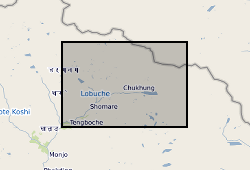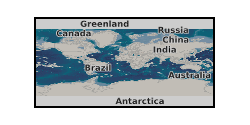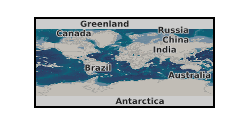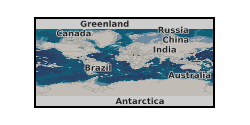University of Leeds
Type of resources
Topics
Keywords
Contact for the resource
Provided by
Years
Formats
Representation types
Update frequencies
Resolution
-

These data consist of a spreadsheet containing 557 ground control points (GCPs) collected in the Everest region of Nepal between October 2015 and October 2016. GCPs were collected using a Leica GS10 differential Global Positioning System (dGPS), post-processed against base station data at Syangboche. These final data have sub-centimetre accuracy (in x, y and z) in all cases. Point positions are heavily concentrated around meltwater ponds on the glacier surface, and prominent features around the glacier margin. These data will be used by PhD students and staff in the School of Geography, University of Leeds, to provide ground control for fine-resolution satellite imagery and Structure-from-Motion surveys to assess mass loss processes on Khumbu Glacier.
-

This data set contains example input and output files from density functional theory calculations of rare earth systems, using the Vienna Ab initio Simulation Package (VASP), The data set it split into two parts. The first data set contains the input and output files of molecular dynamics simulations of MCl3 in solution, where (M = Nd, Gd and Er) at ambient conditions, which was modelled at 341 K using the optB88 exchange-correlation functional. The calculations were run in order to investigate speciation in rare earth chloride solutions, including trends across the row, using a light (Nd), medium (Gd) and heavy (Er) rare earth. These particular calculations were used to validate classical interatomic potentials that were used to perform more complex simulation on larger systems and longer timescales. Only the first 2 ps of the trajectories are deposited here, since the complete trajectories are large. The second data set contains example input and output files for lattice dynamics calculations of the thermodynamics properties (heat capacity and entropy) of Nd-monazite and Nd-xenotime at ambient conditions up to 1200 K. In addition, it includes scripts for processing and plots of final results. These are useful for thermodynamical modelling of rare earth systems. Only the input and output files for Nd are deposited here, since the files are large and input files for Gd and Er are identical, save for the change in element.
-
These data comprise input and output files from first principles molecular dynamics calculations on the soil mineral kaolinite, detailing its interactions with four different veterinary antibiotics, namely enrofloxacin, florfenicol, ciprofloxacin and florfenicol amine. The dataset includes the final, complete molecular dynamics trajectories of the sorption process of each antibiotic on the mineral surfaces (Al-terminated or Si-terminated). The data were collected as part of the NERC Exploring the Frontiers grant (Grant No. NE/X009572/1), ‘Antibiotic chemistry in agricultural soils: modelling mineral-antibiotic interactions from first principles’. The work fits within the broad field of ‘emerging contaminants’ in the environment, and understanding drivers of antimicrobial resistance (AMR). Full details about this nonGeographicDataset can be found at https://doi.org/10.5285/ce86e353-5068-48a6-99bc-4898201d6e6b
-
This data contains the results of student and professional perceptions surveys conducted in the UK before and after e-Learning training, as part of a project to determine the effectiveness of e-Learning as a training tool. The dataset include two surveys; before and after e-Learning training. Students and professionals were given two separate surveys which were combined to create one dataset. The surveys were collected between September 2015 and July 2018. The objective of the survey was to collect data on participants’ awareness, risk perceptions and self-reported behaviours on biosecurity for invasive species. The topics on both the before and after survey included age, role at institution, field of work/study, field activity environments, cleaning methods for equipment, outerwear/footwear and transport and awareness and perceptions of risk around invasive species and biosecurity campaigns. The data does not include the aggregated cleaning scores that were used for the analysis nor has it excluded any participants that were not used in the final data analysis. The dataset has been anonymised by removing names of respondents, email addresses, departments or organisations worked for or studied in, and text responses which could have made the participant identifiable. The research was funded by NERC project no NE/N008391/1. Full details about this nonGeographicDataset can be found at https://doi.org/10.5285/ac271791-b722-489c-9b68-b37316ec826c
-
The datasets contains species presence and background points, and their associated environmental data for non-native common wall lizard (Podarcis muralis). These data are included for local and national scale modelling of likelihood of species presence, as used in the modelling software MaxEnt. The .asc files included are the raw spatial data of parameters (i.e., distance to nearest road) used in modelling at various local regions, from which SWD 'samples with data' were extracted. Outputs from the local MaxEnt models produced the .txt files included. These serve as landscape layer inputs (habitat suitability and movement cost layers) for modelling population growth and spatial spread in the Individual based modelling platform, RangeShifter. Subsequent outputs of projected population growth (number of individuals per landscape cell) and x/y coordinates for each cell, are presented in files with the prefix Pop.csv and avg.csv (averaged data over 50 replicate runs). Full details about this dataset can be found at https://doi.org/10.5285/8ae3f9ef-9a75-4237-afbd-e01abe02e75b
-
The dataset provides transcripts from focus groups in Salima, Mangochi and Zomba (Malawi). The focus groups' discussions concern the monthly agricultural activities in association with the climate services and extreme weather events. The data were produced as part of NERC Program Science for Humanitarian Emergencies and Resilience (SHEAR). Grant reference - Improving Preparedness to Agro-Climatic Extremes in Malawi (IPACE-Malawi). Full details about this dataset can be found at https://doi.org/10.5285/2b8cb09f-9348-4115-a90e-818eade599af
-
The dataset provides transcripts from focus groups in Salima, Mangochi and Zomba (Malawi). The focus groups' discussions focused on important monthly agricultural activities in association with the climate services and extreme weather events. This outlined how climatic factors affected agricultural decision-making. The data were produced as part of NERC Program Science for Humanitarian Emergencies and Resilience (SHEAR). Grant reference - Improving Preparedness to Agro-Climatic Extremes in Malawi (IPACE-Malawi). Full details about this dataset can be found at https://doi.org/10.5285/199b0046-79a3-4e74-8152-17f10c376671
-

Output from the FAMOUS General Circulation Model presented in the study by Dentith et al. (2018) "Ocean circulation drifts in multi-millennial climate simulations: the role of salinity corrections and climate feedbacks". The following ocean variables are included at model resolution (2.5 ° x 3.75 °): salinity, meridional overturning streamfunction, potential temperature, mixed layer depth, and barotropic streamfunction. Precipitation, evaporation and sea ice concentration data are also included at atmospheric resolution (5 ° x 7.5 °). All data has been processed into netCDF timeseries.
-

This poster on the UKCCSRC Call 2 project Investigating the radiative heat flux in small and large scale oxy-coal furnaces for CFD model development and system scale up was presented at the CSLF Call project poster reception, London, 27.06.16. Grant number: UKCCSRC-C2-193. Oxy-fuel (coal or biomass) combustion significantly changes the heat transfer properties of power plant furnaces. Thus future power plants using oxy-fuel technology will rely greatly on computational modelling. This project aims to collect combustion and heat transfer data from both small and large scale furnaces and to validate the computational model in order to make it ready for future technology scale up. Specific objectives are: • Take measurements at the 250 kW oxy-coal furnace at PACT national facilities in Sheffield, including combustion and heat transfer data. • Take measurements at a 35 MW oxy-coal furnace in China. • Validate CFD models developed and investigate the combustion and heat transfer properties in both large and small furnaces.
-

This poster on the UKCCSRC Call 2 project, Investigating the radiative heat flux in small and large scale oxy-coal furnaces for CFD model development and system scale up, was presented at the Cardiff Biannual, 10.09.14. Grant number: UKCCSRC-C2-193.
 NERC Data Catalogue Service
NERC Data Catalogue Service